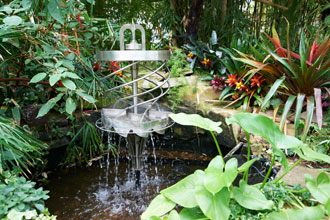Tokina AT-X 16-28mm f/2.8 PRO FX
Tokina AT-X 16-28mm f/2.8 PRO FX: Performance
Shooting wide open at 16mm, sharpness in the centre of the image is already good, with the quality towards the edges not too far behind. Stopping the lens down improves sharpness across the frame until f/8, where the lens performs excellently in the centre and is very good towards the edges.At 20mm, the very good centre sharpness in maintained at f/2.8, but the quality towards the edges drops to fair levels. Just as at 16mm, peak quality across the frame is achieved at f/8, where the sharpness in the centre reaches excellent levels again, and the quality towards the edges is also very good.
Finally at 28mm, the sharpness in the centre of the image remains very good at f/2.8, and just as at 20mm, the quality towards the edges remains fair. Stopping down doesn't have as much effect on the quality towards the edges as it does at shorter focal lengths and sharpness levels here don't exceed good levels until f/16. However it does have a dramatic effect on the sharpness in the centre, which exceeds excellent levels at f/4.
| Resolution at 16mm | Resolution at 20mm | |
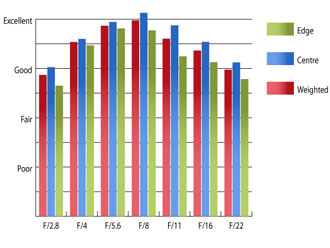 | 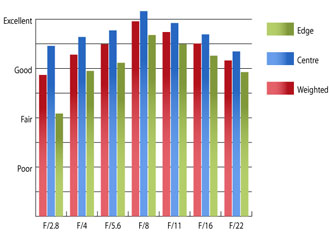 | |
| Resolution at 28mm | How to read our graphsThe blue column represents readings from the centre of the picture frame at the various apertures and the green is from the edges. Averaging them out gives the red weighted column.The scale on the left side is an indication of actual image resolution. The taller the column, the better the lens performance. Simple. For this review, the lens was tested on an Nikon D300 using Imatest. | |
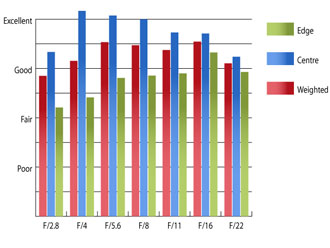 |
Levels of chromatic aberrations towards the edges are quite high throughout the zoom range, with fringing regularly exceeding 1.5 pixel widths. This amount of fringing may cause issues in images with high contrast towards the edges of the frame, and may be visible in large prints if not corrected in image editing software.
| Chromatic Aberrations at 16mm | Chromatic Aberrations at 20mm | |
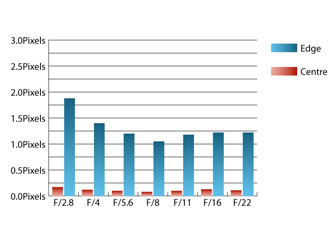 | 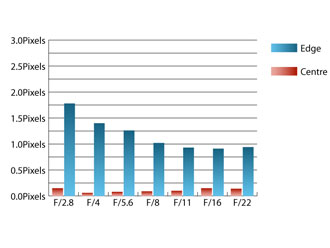 | |
| Chromatic Aberrations at 28mm | How to read our chartsChromatic aberration is the lens' inability to focus on the sensor or film all colours of visible light at the same point. Severe chromatic aberration gives a noticeable fringing or a halo effect around sharp edges within the picture. It can be cured in software.Apochromatic lenses have special lens elements (aspheric, extra-low dispersion etc) to minimize the problem, hence they usually cost more. For this review, the lens was tested on an Nikon D300 using Imatest. | |
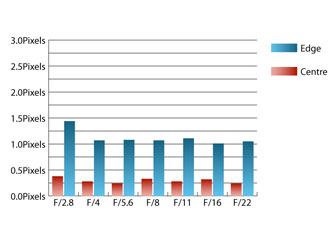 |
For a lens with such a wide field of view and a fast maximum aperture of f/2.8, falloff of illumination towards the corners is very well controlled. At 16mm the corners are 1.7stops darker than the image centre and at 28mm this is reduced to 0.7stops. Visually uniform illumination is achieved at f/5.6 throughout the zoom range.
Distortion isn't particularly well corrected throughout the zoom range. At 16mm 9.32% barrel distortion is present and at 28mm, this drops to 5.92%. This amount of distortion will be visible in images with straight lines, but luckily the distortion pattern is uniform across the frame, so it should be relatively simple to straighten things up in image editing software afterwards.
Due to the nature of the large curved front element, flare can be an issue, especially with strong point sources of light just outside the frame, such as the sun. Although the flare created looks quite pretty, it is not always desirable. Luckily levels on contrast hold up quite well in these conditions, so all is not lost.
Add your message
Login required
Please login here or if you've not registered, you can register here. Registering is safe, quick and free.
Please login here or if you've not registered, you can register here. Registering is safe, quick and free.
photodo Stats
1102 lenses
428 MTF tests
74 in-depth photodo reviews
100+ users join each day
Help the lens community by reviewing or rating a lens today via our lens search
428 MTF tests
74 in-depth photodo reviews
100+ users join each day
Help the lens community by reviewing or rating a lens today via our lens search
Latest Lens Reviews
- Chinon 28mm f/2.8 Vintage Lens Review
- Canon EF 70-200mm f/4L IS II USM Lens Review
- Samyang AF 85mm f/1.4 EF Review
- Sigma 70mm f/2.8 DG Macro Art Review
- Samyang AF 24mm f/2.8 FE Review
- Meike 50mm f/1.7 Review
- Tamron 70-210mm f/4 Di VC USD Review
- Lensbaby Burnside 35mm f/2.8 Review
- Asahi Super Takumar 50mm f/1.4 Review
- Asahi Super-Multi-Coated Takumar 135mm f/3.5 Review




